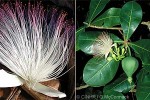Cook Islands Biodiversity Database
Species Page
Barringtonia asiatica
‘UtuBarringtonia
Multimedia & Additional Resources
| Type | Description | Download |
| Leaves, flower and fruit | 71KB |
General Information
Cook Islands Distribution
| Southern Group: Present Makatea: Present | ||||||||
RR |
MG |
AT |
MK |
MT |
AK |
PL |
TK |
MN |
+++ |
++++ |
++++ |
+++ |
++ |
++? |
+ |
+ |
- |
| Northern Group: Present | |||||
TN |
MH |
RK |
PK |
NS |
SW |
+IR |
P |
P |
+ |
- |
P |
Scientific Taxonomy
Barringtonia asiatica Linnaeus
SYNONYMS: Barringtonia speciosa; Barringtonia butonica; Mammea asiatica
TAXONOMY: PLANTAE; ANTHOPHYTA (=Angiospermae); MAGNOLIOPSIDA (=Dicotyledones); DILLENIIDAE; Lecythidales; LECYTHIDACEAE
More Information
SIGNIFICANCE NOTES -. Comment: NBSAP - Mangaia (4 of 4 wild)
POSITIVE SIGNIFICANCE: Medicine, Material (Former Fish Poison). Comments: In the recent past the seed of the ‘Utu was used to poison fish in the lagoon. Seeds were grated or pounded to release their juices and then scattered on the water. This practise is no longer observed following by-laws passed forbidding the use of poisons for fishing. A dressing for burns (and other ailments) called pakapaka is prepared from the seeds also. The wood is used for some boat parts and drums though it is reportedly of poor quality (Whistler 1990). Whistler notes the use of leaves as wound dressings as reported by Gill (1885). Timber is brittle, white and lasts poorly if exposed to the elements.
NEGATIVE SIGNIFICANCE: Poisonous to eat raw seed - serious; Poisonous to fish. Comments: Seed juice formerly used to kill fish.
Vouchers & References
Vouchers:
Pukapuka: fieldspecimen+photo, 2/2004, G.McCormack with ID as Barringtonia asiatica.
References:
p.622 Neal - In Gardens of Hawaii
p.139 Hortus 3rd
p.129 Royal Hort. Soc. Index of Garden Plants
p.536 Tropica
p.2/595 A.C.Smith - Flora Vitiensis Nova
p.280 I Cheeseman - Flora of Rarotonga
p.79 Wilder - Flora of Rarotonga
p.411b Whistler - Ethnobotany of the Cook Islands
p.17 McCormack/Kunzle - Rarotonga's Mountain Tracks and Plants
Data Update History (information):
zTX, zB02, zM02, zupM03a, zD02
Web Resources
Citation Information
McCormack, Gerald (2007) Cook Islands Biodiversity Database, Version 2007.2. Cook Islands Natural Heritage Trust, Rarotonga. Online at http://cookislands.bishopmuseum.org. ![]()
Please refer to our use policy.

